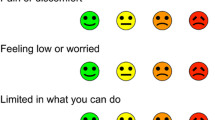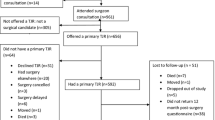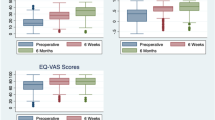Abstract
Purpose
To examine the responsiveness of the EQ-5D-3L and EQ-5D-5L among total hip/knee replacement (THR/TKR) patients.
Methods
The EQ-5D (3L or 5L) and Western Ontario and McMaster University Osteoarthritis Index (WOMAC) have been routinely administered to all THR/TKR patients before and at 3 months after surgery in Alberta, Canada, since 2010. Patients were included in this analysis if they completed the WOMAC and the same version of EQ-5D at baseline and 3-month follow-up. The WOMAC was used as an anchor to categorize patients into 9 subgroups according to the relative change from baseline, i.e., no change, and 4 categories each for the amount of deterioration or improvement: large (≥ 70%), moderate (50% ≤ change < 70%), small but important (20% ≤ change < 50%), and very mild (0 < change ≤ 20%). The responsiveness of the EQ-5D-3L and EQ-5D-5L for each subgroup was assessed using effect size, standardized response mean, and Guyatt’s Responsiveness Index.
Results
A total of 1594 patients completed the EQ-5D-3L and WOMAC (60% females, mean age 66 years, N = 646 [41%] THR), and 3180 completed the EQ-5D-5L and WOMAC (60% females, mean age 66 years, N = 1352 [43.2%] THR) at baseline and 3-month follow-up. For both THR and TKR patients with “small but important” improvement, the EQ-5D-5L was consistently more responsive than the EQ-5D-3L.
Conclusion
Our study demonstrated that the EQ-5D-5L is more responsive than the EQ-5D-3L in identifying health-related quality of life changes in THR/TKR patients. We recommend using the EQ-5D-5L in longitudinal studies in this patient population.

Similar content being viewed by others
References
American Academy of the Orthopedic Surgeons. Total joint replacement. Accessed August 31, 2018, from https://orthoinfo.aaos.org/en/treatment/total-joint-replacement/.
OECD. (2017). Health at a glance 2017: OECD indicators. Paris: OECD Publishing.
Canadian Institute for Health Information. (2018). Hip and knee replacements in Canada, 2016–2017: Canadian joint replacement registry annual report. Ottawa: CIHI.
Guyatt, G. H., Deyo, R. A., Charlson, M., Levine, M. N., & Mitchell, A. (1989). Responsiveness and validity in health status measurement: A clarification. Journal of Clinical Epidemiology, 42(5), 403–408.
Garbuz, D. S., Xu, M., & Sayre, E. C. (2006). Patients’ outcome after total hip arthroplasty. Journal of Arthroplasty, 21(7), 998–1004.
Giesinger, J. M., Hamilton, D. F., Jost, B., Behrend, H., & Giesinger, K. (2015). WOMAC, EQ-5D and knee society score thresholds for treatment success after total knee arthroplasty. Journal of Arthroplasty, 30(12), 2154–2158.
Núñez, M., Lozano, L., Núñez, E., et al. (2009). Total knee replacement and health-related quality of life: Factors influencing long-term outcomes. Arthritis & Rheumatology, 61(8), 1062–1069.
EuroQol Group. EuroQol, About us. Accessed March 1, 2019, from https://euroqol.org/euroqol/.
Rabin, R., Gudex, C., Selai, C., & Herdman, M. (2014). From translation to version management: A history and review of methods for the cultural adaptation of the EuroQol five-dimensional questionnaire. Value in Health, 17(1), 70–76.
Costa, M. L., Achten, J., Foguet, P., Parsons, N. R., & Young Adult Hip Arthroplasty Team. (2018). Comparison of hip function and quality of life of total hip arthroplasty and resurfacing arthroplasty in the treatment of young patients with arthritis of the hip joint at 5 years. British Medical Journal Open, 8(3), e018849.
Fernandes, L., Roos, E. M., Overgaard, S., Villadsen, A., & Søgaard, R. (2017). Supervised neuromuscular exercise prior to hip and knee replacement: 12-month clinical effect and cost-utility analysis alongside a randomised controlled trial. BMC Musculoskeletal Disorders, 18(1), 5.
Jenkins, P. J., Clement, N. D., Hamilton, D. F., Gaston, P., Patton, J. T., & Howie, C. R. (2013). Predicting the cost-effectiveness of total hip and knee replacement: A health economic analysis. Bone & Joint Journal, 95(1), 115–121.
Rosenlund, S., Broeng, L., Holsgaard-Larsen, A., Jensen, C., & Overgaard, S. (2017). Patient-reported outcome after total hip arthroplasty: Comparison between lateral and posterior approach. Acta Orthopaedica, 88(3), 239–247.
Insight & Feedback Team, NHS England. (2017). National patient reported outcome measures (PROMs) programme consultation report. London: NHS.
Kärrholm J, Lindahl H, Malchau H, et al. The swedish hip arthroplasty register annual report 2016. Accessed August 31, 2018, from https://registercentrum.blob.core.windows.net/shpr/r/Annual-Report-2016-B1eWEH-mHM.pdf.
Canadian Institute for Health Information. (2015). PROMs forum proceedings. Ottawa: CIHI.
Conner-Spady, B., Marshall, D., Bohm, E., et al. (2015). Reliability and validity of the EQ-5D-5L compared to the EQ-5D-3L in patients with osteoarthritis referred for hip and knee replacement. Quality of Life Research, 24(7), 1775–1784.
Brazier, J., Roberts, J., Tsuchiya, A., & Busschbach, J. (2004). A comparison of the EQ-5D and SF-6D across seven patient groups. Health Economics, 13(9), 873–884.
Johnson, J. A., & Pickard, A. S. (2000). Comparison of the EQ-5D and SF-12 health surveys in a general population survey in Alberta, Canada. Medical Care, 38(1), 115–121.
Herdman, M., Gudex, C., Lloyd, A., Janssen, M., Kind, P., Parkin, D., et al. (2011). Development and preliminary testing of the new five-level version of EQ-5D (EQ-5D-5L). Quality of Life Research, 20(10), 1727–1736.
Greene, M., Rader, K., Garellick, G., Malchau, H., Freiberg, A., & Rolfson, O. (2015). The EQ-5D-5L improves on the EQ-5D-3L for health-related quality-of-life assessment in patients undergoing total hip arthroplasty. Clinical Orthopaedics and Related Research, 473(11), 3383–3390.
Conner-Spady, B., Marshall, D., Bohm, E., Dunbar, M., & Noseworthy, T. (2018). Comparing the validity and responsiveness of the EQ-5D-5L to the oxford hip and knee scores and SF-12 in osteoarthritis patients 1 year following total joint replacement. Quality of Life Research, 27(5), 1311–1322.
Bilbao, A., García-Pérez, L., Arenaza, J. C., García, I., Ariza-Cardiel, G., Trujillo-Martín, E., et al. (2018). Psychometric properties of the EQ-5D-5L in patients with hip or knee osteoarthritis: Reliability, validity and responsiveness. Quality of Life Research, 27(11), 2897–2908.
Marshall, D. A., Christiansen, T., Smith, C., et al. (2015). Continuous quality improvement program for hip and knee replacement. American Journal of Medical Quality, 30(5), 425–431.
EuroQol Group. EQ-5D-3L user guide. Accessed May 11, 2018, from https://euroqol.org/wp-content/uploads/2016/09/EQ-5D-3L_UserGuide_2015.pdf.
EuroQol Group. EQ-5D-5L user guide. Accessed May 11, 2018, from https://euroqol.org/wp-content/uploads/2016/09/EQ-5D-5L_UserGuide_2015.pdf.
Bansback, N., Tsuchiya, A., Brazier, J., & Anis, A. (2012). Canadian valuation of EQ-5D health states: Preliminary value set and considerations for future valuation studies. PLoS ONE, 7(2), e31115.
Xie, F., Pullenayegum, E., Gaebel, K., et al. (2016). A time trade-off-derived value set of the EQ-5D-5L for Canada. Medical Care, 54(1), 98–105.
Bellamy, N. (2004). WOMAC osteoarthritis index user guide VII. Brisbane: The University of Queensland.
Impellizzeri, F. M., Mannion, A. F., Leunig, M., Bizzini, M., & Naal, F. D. (2011). Comparison of the reliability, responsiveness, and construct validity of 4 different questionnaires for evaluating outcomes after total knee arthroplasty. Journal of Arthroplasty, 26(6), 861–869.
Quintana, J. M., Escobar, A., Bilbao, A., Arostegui, I., Lafuente, I., & Vidaurreta, I. (2005). Responsiveness and clinically important differences for the WOMAC and SF-36 after hip joint replacement. Osteoarthritis and Cartilage, 13(12), 1076–1083.
Wolfe, F., & Kong, S. X. (1999). Rasch analysis of the Western Ontario McMaster questionnaire (WOMAC) in 2205 patients with osteoarthritis, rheumatoid arthritis, and fibromyalgia. Annals of the Rheumatic Diseases, 58(9), 563–568.
Terwee, C. B., Bot, S. D., de Boer, M. R., van der Windt, D. A., Knol, D. L., Dekker, J., et al. (2007). Quality criteria were proposed for measurement properties of health status questionnaires. Journal of Clinical Epidemiology, 60(1), 34–42.
Sonntag, M., König, H. H., & Konnopka, A. (2015). The responsiveness of the EQ-5D and time trade-off scores in schizophrenia, affective disorders, and alcohol addiction. Health and Quality of Life Outcomes, 13, 114.
Turner, D., Schünemann, H. J., Griffith, L. E., et al. (2009). Using the entire cohort in the receiver operating characteristic analysis maximizes precision of the minimal important difference. Journal of Clinical Epidemiology, 62(4), 374–379.
Mukaka, M. M. (2012). A guide to appropriate use of correlation coefficient in medical research. Malawi Medical Journal, 24(3), 69–71.
Cohen, J. (1988). Statistical power analysis for the behavioral sciences. New York: Routledge Academic.
Golicki, D., Niewada, M., Karlińska, A., et al. (2015). Comparing responsiveness of the EQ-5D-5L, EQ-5D-3L and EQ VAS in stroke patients. Quality of Life Research, 24(6), 1555–1563.
Chen, P., Lin, K., Liing, R., Wu, C., Chen, C., & Chang, K. (2016). Validity, responsiveness, and minimal clinically important difference of EQ-5D-5L in stroke patients undergoing rehabilitation. Quality of Life Research, 25(6), 1585–1596.
Cheung, P., Wong, C., Lau, S., & Cheung, J. (2018). Responsiveness of the EuroQoL 5-dimension (EQ-5D) in adolescent idiopathic scoliosis. European Spine Journal, 27(2), 278–285.
Nolan, C. M., Longworth, L., Lord, J., et al. (2016). The EQ-5D-5L health status questionnaire in COPD: Validity, responsiveness and minimum important difference. Thorax, 71(6), 493–500.
Bhadhuri, A., Jowett, S., Jolly, K., & Al-Janabi, H. (2017). A comparison of the validity and responsiveness of the EQ-5D-5L and SF-6D for measuring health spillovers: A study of the family impact of meningitis. Medical Decision Making, 37(8), 882–893.
Oppe, M., Devlin, N., & Black, N. (2011). Comparison of the underlying constructs of the EQ-5D and Oxford Hip Score: Implications for mapping. Value in Health, 14(6), 884–891.
Jin, X., Al Sayah, F., Ohinmaa, A., Marshall, D. A., Smith, C., & Johnson, J. A. (2019). The EQ-5D-5L is superior to the -3L version in measuring health-related quality of life in patients awaiting THA or TKA. Clinical Orthopaedics and Related Research. https://doi.org/10.1097/CORR.0000000000000662.
Benson, T., Williams, D. H., & Potts, H. W. (2016). Performance of EQ-5D, howRu and Oxford hip & knee scores in assessing the outcome of hip and knee replacements. BMC Health Services Research, 16(1), 512.
Alberta Bone and Joint Health Institute. Wait times for hip and knee replacement. Accessed January 8, 2019, from https://albertaboneandjoint.com/patients/wait-times/.
Middel, B., & van Sonderen, E. (2002). Statistical significant change versus relevant or important change in (quasi) experimental design: Some conceptual and methodological problems in estimating magnitude of intervention-related change in health services research. International Journal of Integrated Care, 2(4), e15.
Sivan, M. (2009). Interpreting effect size to estimate responsiveness of outcome measures. Stroke, 40(12), e709.
Acknowledgments
We thank EuroQol Research Foundation for supporting this study.
Author information
Authors and Affiliations
Corresponding author
Ethics declarations
Conflict of interest
The authors declare that they have no conflict of interest.
Ethical approval
The data used in this analysis was collected as part of standard of care, and not part of a clinical study. As such, it was captured under the authority of the provincial Privacy Impact Analysis in place for quality assurance monitoring and reporting on Bone and Joint Health in Alberta (OIPC File # H2801). Participants do not provide consent.
Additional information
Publisher's Note
Springer Nature remains neutral with regard to jurisdictional claims in published maps and institutional affiliations.
Electronic supplementary material
Below is the link to the electronic supplementary material.
Rights and permissions
About this article
Cite this article
Jin, X., Al Sayah, F., Ohinmaa, A. et al. Responsiveness of the EQ-5D-3L and EQ-5D-5L in patients following total hip or knee replacement. Qual Life Res 28, 2409–2417 (2019). https://doi.org/10.1007/s11136-019-02200-1
Accepted:
Published:
Issue Date:
DOI: https://doi.org/10.1007/s11136-019-02200-1




